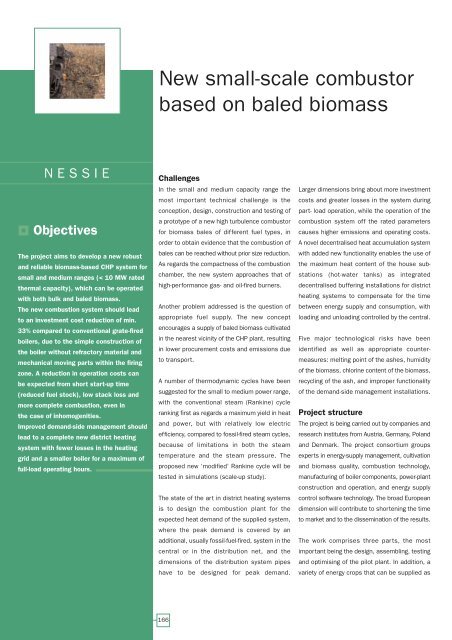European Bio-Energy Projects
European Bio-Energy Projects
European Bio-Energy Projects
You also want an ePaper? Increase the reach of your titles
YUMPU automatically turns print PDFs into web optimized ePapers that Google loves.
NESSIE<br />
Objectives<br />
The project aims to develop a new robust<br />
and reliable biomass-based CHP system for<br />
small and medium ranges (< 10 MW rated<br />
thermal capacity), which can be operated<br />
with both bulk and baled biomass.<br />
The new combustion system should lead<br />
to an investment cost reduction of min.<br />
33% compared to conventional grate-fired<br />
boilers, due to the simple construction of<br />
the boiler without refractory material and<br />
mechanical moving parts within the firing<br />
zone. A reduction in operation costs can<br />
be expected from short start-up time<br />
(reduced fuel stock), low stack loss and<br />
more complete combustion, even in<br />
the case of inhomogenities.<br />
Improved demand-side management should<br />
lead to a complete new district heating<br />
system with fewer losses in the heating<br />
grid and a smaller boiler for a maximum of<br />
full-load operating hours.<br />
New small-scale combustor<br />
based on baled biomass<br />
Challenges<br />
In the small and medium capacity range the<br />
most important technical challenge is the<br />
conception, design, construction and testing of<br />
a prototype of a new high turbulence combustor<br />
for biomass bales of different fuel types, in<br />
order to obtain evidence that the combustion of<br />
bales can be reached without prior size reduction.<br />
As regards the compactness of the combustion<br />
chamber, the new system approaches that of<br />
high-performance gas- and oil-fired burners.<br />
Another problem addressed is the question of<br />
appropriate fuel supply. The new concept<br />
encourages a supply of baled biomass cultivated<br />
in the nearest vicinity of the CHP plant, resulting<br />
in lower procurement costs and emissions due<br />
to transport.<br />
A number of thermodynamic cycles have been<br />
suggested for the small to medium power range,<br />
with the conventional steam (Rankine) cycle<br />
ranking first as regards a maximum yield in heat<br />
and power, but with relatively low electric<br />
efficiency, compared to fossil-fired steam cycles,<br />
because of limitations in both the steam<br />
temperature and the steam pressure. The<br />
proposed new ‘modified’ Rankine cycle will be<br />
tested in simulations (scale-up study).<br />
The state of the art in district heating systems<br />
is to design the combustion plant for the<br />
expected heat demand of the supplied system,<br />
where the peak demand is covered by an<br />
additional, usually fossil-fuel-fired, system in the<br />
central or in the distribution net, and the<br />
dimensions of the distribution system pipes<br />
have to be designed for peak demand.<br />
166<br />
Larger dimensions bring about more investment<br />
costs and greater losses in the system during<br />
part- load operation, while the operation of the<br />
combustion system off the rated parameters<br />
causes higher emissions and operating costs.<br />
A novel decentralised heat accumulation system<br />
with added new functionality enables the use of<br />
the maximum heat content of the house substations<br />
(hot-water tanks) as integrated<br />
decentralised buffering installations for district<br />
heating systems to compensate for the time<br />
between energy supply and consumption, with<br />
loading and unloading controlled by the central.<br />
Five major technological risks have been<br />
identified as well as appropriate countermeasures:<br />
melting point of the ashes, humidity<br />
of the biomass, chlorine content of the biomass,<br />
recycling of the ash, and improper functionality<br />
of the demand-side management installations.<br />
Project structure<br />
The project is being carried out by companies and<br />
research institutes from Austria, Germany, Poland<br />
and Denmark. The project consortium groups<br />
experts in energy-supply management, cultivation<br />
and biomass quality, combustion technology,<br />
manufacturing of boiler components, power-plant<br />
construction and operation, and energy supply<br />
control software technology. The broad <strong>European</strong><br />
dimension will contribute to shortening the time<br />
to market and to the dissemination of the results.<br />
The work comprises three parts, the most<br />
important being the design, assembling, testing<br />
and optimising of the pilot plant. In addition, a<br />
variety of energy crops that can be supplied as

















